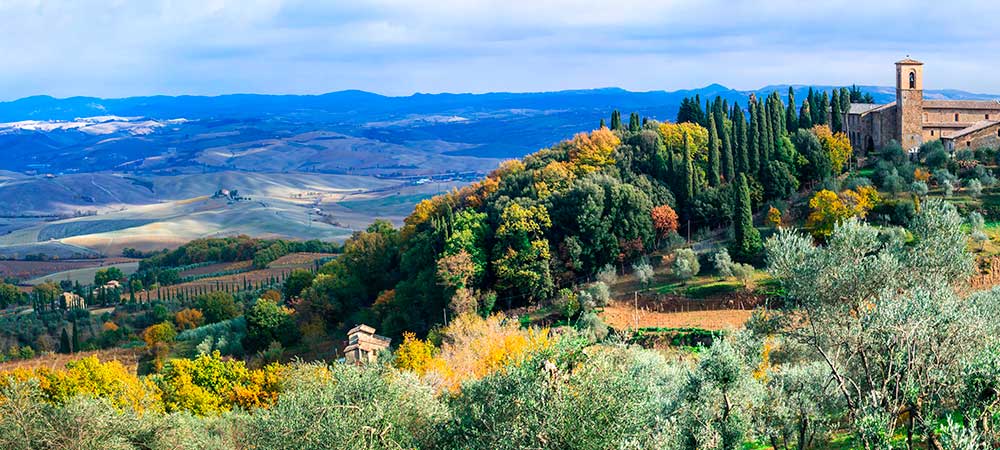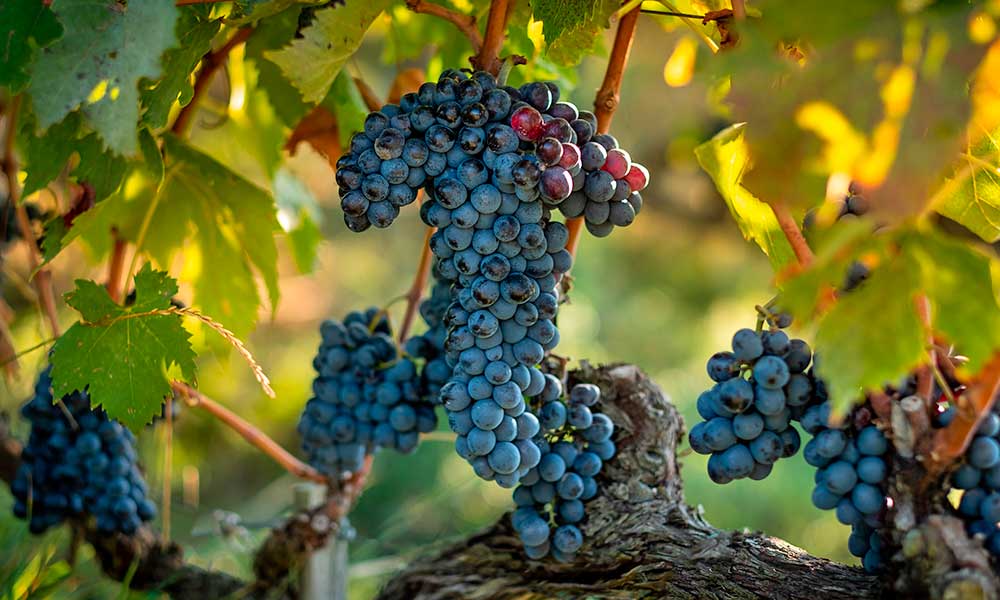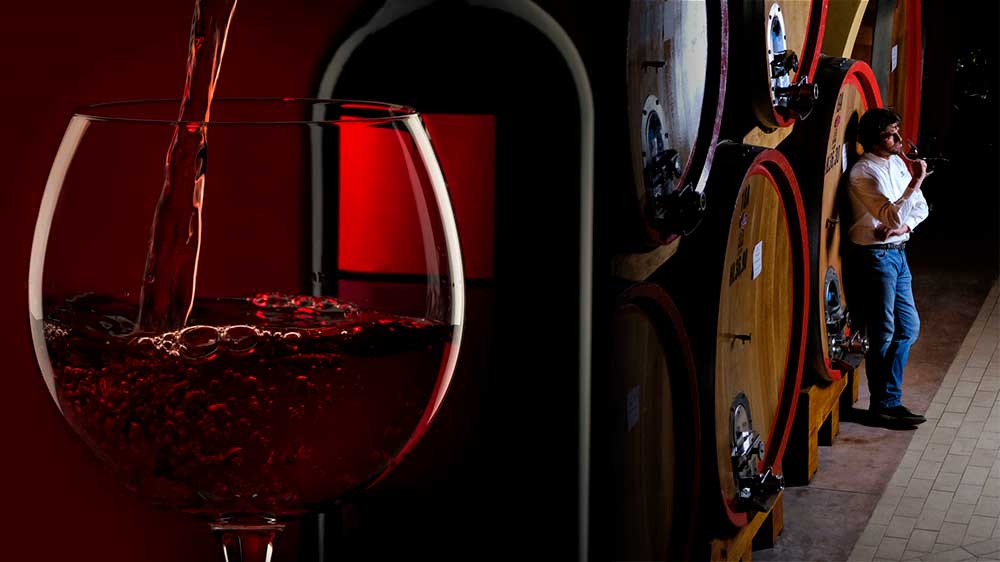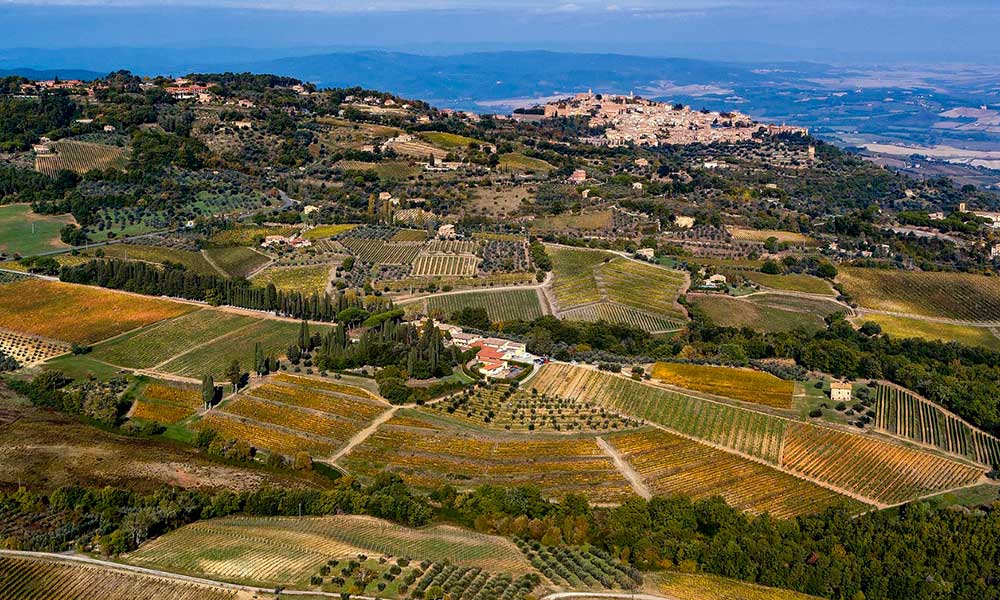 The village of Montalcino has barely changed in appearance since the 16th century.
The village of Montalcino has barely changed in appearance since the 16th century.
A friend in the restaurant game recently mentioned that Brunello is suddenly the hottest thing on her wine list. But what exactly is it?
Brunello di Montalcino, often referred to simply as Brunello, is an Italian wine term you’ve no doubt heard but may not know well. It gets easily confused with Montepulciano, Vino Nobile di Montepulciano, Montepulciano d’Abruzzo and even Barolo, but Brunello is worth singling out.
“A great Brunello is a wine of incomparible refinement, power and ageworthiness.” Decanter Magazine.
“Italy’s most famous and premium wine appellation.” James Suckling, who visited in the early ’80s and then lived there for several years.
“Tuscany’s grandest wine zone.” Jancis Robinson.
Brunello is one of Italy’s most prestigious and expensive wines and, along with Barolo, is often referred to as the ‘King of Italian Wines.’ It’s a red wine originating from the vineyards around Montalcino, a stunning medieval hilltop town located about 110km south of Florence, in Tuscany.
While wine has been made in this area for hundreds of years, it was not until 1865 that wine labelled Brunello appeared, and 1888 that it was bottled under the specific name of Brunello di Montalcino. Brunello was recognised as a DOC (appellation) in 1966 soon after the scheme was first implemented but remained relatively unknown until two events set Montalcino and Brunello on a path to worldwide acclaim.
First, the Mariani brothers, Italian New Yorkers importing the hugely successful Lambrusco, travelled to Montalcino in the late 70s, in search of new suppliers. The timing was perfect. Impoverished locals were all too happy to sell their wine and, at a nudge, their land. The Marianis created Banfi winery, paving the way for Brunello’s success in the American market. Second, a terrible frost in early 1985 destroyed many of the region’s olive trees and seeing the recent success of the two brothers, local vignerons were inspired to replant vines.
In the meantime, in 1980, Brunello was upgraded to one of the first five DOCGs - the highest level in the Italian wine classification system. The other 4 were Barolo, Barbaresco, Chianti and Vino Nobile di Montalcino. The region has grown from a mere 65ha in 1960 to 3,500 ha today - still tiny compared to Bordeaux at around 120,000 ha.
 Sangiovese grapes growing around Montalcino.
Sangiovese grapes growing around Montalcino.
The term Brunello was the name traditionally given to the grape variety grown around Montalcino. These days we know it to be a strain of sangiovese, Italy’s most widely planted variety. Aside from Brunello, sangiovese is responsible for several of Tuscany’s most notable wines; Chianti, Vino Nobile di Montepulciano and most of the ‘Super Tuscans.’ But it’s in Brunello that sangiovese finds its most famous expression, producing the richest, fullest and boldest examples of the variety. The reason for this is the climate. Even though Brunello is fairly close to Chianti, it’s slightly warmer and drier than most of Chianti during the day, and with the sea only 25km away, Brunello also enjoys a cool maritime breeze, ensuring excellent ventilation and cooler nights. This diurnal variation means a long growing season (good for flavour development) and maximum ripeness.
Brunello is characterised by firm acidity and moderate to high tannin. The best examples have “luscious, bold, rich black and red fruit flavours.” Wine Spectator Magazine. More specifically you’ll find flavours of blackberry, cherry, raspberry, chocolate aged balsamic and minerals, ageing to fig, sweet tobacco, espresso and leather. If stored well, it’ll cellar for between 10-30 years. As the Oxford Companion to Wine notes: “Brunello is one of Italy’s most noble and long-lived wines.”
In terms of DOCG requirements, Brunello must be made from 100% sangiovese, aged for a minimum of 2 years in oak and a minimum of 4 months (6 for Riserva) in bottle. It cannot be released until 5 years (6 years for Riserva) after the date of harvest. Since 1984, there’s been a separate appellation known as Rosso di Montalcino DOC, also 100% sangiovese. It has no minimum aging requirements and can be released on the 1st September, following the year of harvest. Interestingly, all three (Rosso, Brunello and Riserva) can only be sold in Bordeaux shaped bottles.
I’m pleased to be able to offer you two top-tier Brunello producers, both hard to procure, one with releases ready to drink now, the other best left in your cellar for many years.
La Serena
“Proprietor Andrea Mantengoli can be counted on for rich, powerful wines full of character at La Serena.” Antonio Galloni.
“His wines meet that elusive sweet point between power and elegance that is so difficult to achieve.” Wine Advocate.
 Andrea Mantengoli.
Andrea Mantengoli.
The Mantengoli family has owned La Serena estate since the 1930s but did not start making wine until the late 80s, when twin brothers Andrea and Marcello joined the business. These days the estate has 6ha under vine, which since 2013 have been certified organic, which means no use of chemical herbicides or fertilisers.
The estate sits a few kilometres to the east of the town of Montalcino and at an elevation of about 400m. La Serena is well positioned, counting amongst its neighbours another favourite of mine Casanova di Neri as well as legendary Biondi-Santi (see below).
 La Serena Rosso di Montalcino DOC 2018
La Serena Rosso di Montalcino DOC 2018
Entry level Brunello, offering a bright, clear expression and made to drink on release. Estate grown fruit was fermented in stainless steel, followed by 12 months in mixed barrels. Winemaker Andrea Mantengoli describes the wine as “harmonious and elegant. It has good intensity and fragrance, in which one recognizes scents of fresh fruit. To the taste it is harmonious, with vigour and freshness and a good persistence.” The finished wine is 14.5% and sealed with cork.
No reviews around, but I do like this note from one of my favourite UK institutions, Berry Bros & Rudd “With rose, balsamic and wood spice on the nose, the palate is plump, cherry-like and glossy. Supple, chewy tannins lead to a mineral bite; it’s stunning. Drink 2021-2028.”
Your chance to get your hands on great entry level Brunello…
I can offer it for $60 a bottle.
 La Serena 2016 Brunello di Montalcino DOCG 2016
La Serena 2016 Brunello di Montalcino DOCG 2016
This wine was fermented in steel, followed by 30 months in large mixed wooden barrels - the traditional Brunello way. 2016 was considered a near perfect vintage in Brunello, with Decanter Magazine describing it as “a five-star vintage of modern classics with wines showing extraordinary depth, detail and balance.” Eric Giudo of Vinous had this to say… “If I had to think of one way to universally describe the majority of wines from the 2016 vintage, I would offer that they are like a well-muscled black stallion in its prime. They are dark yet radiant, expressive, nearly explosive at times, yet pure, poised and structured. These are wines that capture your imagination.” Wowsers. The wine is 14.5% and sealed with cork.
With 6 years under its belt, this wine is starting to look great, with the tannins softened enough to nicely integrate with the fruit. This from Berry Bros & Rudd: “This is a complete Brunello, exaggerated by the perfect vintage; it’s ripe and shiny with charming power. The palate is full, with plum-soaked richness, zesty cranberry flashes, firm velvet tannins and electric mineral grip.”
“This supple, fluid Brunello offers a compelling mix of bright cherry, black currant and violet aromas and flavors meshed with balsamic notes of juniper, eucalyptus and licorice. Balanced, showing ample structure, with a lingering aftertaste. Best from 2022 through 2040.”
94 points, Wine Spectator.
“Lovely depth of fruit to this young Brunello with tile and tar undertones, as well as bark. It’s full-bodied and layered with soft tannins. From organically grown grapes. Drink after 2022.”
94 points, James Suckling.
Very pleasurable drinking.
I can offer it for $149 a bottle.
 La Serena Brunello di Montalcino DOCG Gemini Riserva 2015
La Serena Brunello di Montalcino DOCG Gemini Riserva 2015
The Gemini Riserva is made from the best fruit on the estate, picked two weeks after the Rosso to give it more power. The wine was fermented and aged in large conical wooden tanks for 36 months. 2015 was an excellent vintage and the finished wine is 15% alcohol, sealed with cork.
“If you prefer your Sangiovese on the fruity side, this red is for you. Black cherry, black currant, licorice, vanilla and spice flavors are in step with the solid structure. Balanced, ending ripe and long on the finish. Best from 2024 through 2045.”
95 points, Wine Spectator.
“A firm, linear red with plum, berry, dark chocolate and mushroom character. It’s full-to medium-bodied with a solid core of tannins to the ripe fruit. A rather traditional, tight red. From organically grown grapes. Better after 2024.”
95 points, James Suckling.
“The 2015 Brunello di Montalcino Riserva Gemini is fruit-forward and a bit extroverted yet impossible to ignore. It boasts a striking mix with intense raspberry preserves, exotic spices and dusty dried florals. Its textures are soft and fleshy, creating a creamy feel to its radiant, ripe fruit profile, while maintaining balance through brisk acids and grippy tannins. The 2015 Gemini takes a turn toward austerity, finishing structured and grippy; yet through it all, sweet violet florals resonate. This may be a full-throttle and extroverted effort, but it’s well balanced and sure to have a lot of fans. Important to note that this was checked in on and held up beautifully over the course of three days. 2024-2034.”
94 points, Eric Guido, Vinous.
I can offer it for $290 a bottle (only 6 bottles available).
Biondi-Santi
In 1999, prestigious US magazine Wine Spectator ran an article proposing the ultimate mixed dozen of the 20th century. Alongside several anticipated gems such as 1900 Château Margaux, 1921 Château d’Yquem, 1937 Domaine de la Romanée-Conti, 1945 Château Mouton Rothschild and 1955 Penfolds Grange was a 1955 Biondi-Santi Brunello Riserva. It’s no surprise Biondi-Santi is regarded as one of, if not the greatest estate in Tuscany, or indeed Italy.
 Located in the heart of Montalcino, Biondi-Santi estate consists 25 hectares of vines on soils rich in heavy stone and marl – perfect for the cultivation of Sangiovese Grosso.
Located in the heart of Montalcino, Biondi-Santi estate consists 25 hectares of vines on soils rich in heavy stone and marl – perfect for the cultivation of Sangiovese Grosso.
The estate was founded by chemistry graduate Clemente Santi in the mid-1800s. His first wine to bear the Brunello name was an 1865 vintage red, entered into the nearby town of Montepulciano’s agricultural fair. Then the 1888 vintage saw his grandson Ferruccio Biondi-Santi produce a wine that officially became the first Brunello di Montalcino.
“Only four vintages -1888, 1891, 1925 and 1945 were declared by Bondi-Santi in the first 57 years of production, contributing an aura of rarity to the wine that translated into high prices and, in Italy at least, incomparable prestige. The Biondi-Santi were the only commercial producers until after the Second World War and a government report of 1932 named Brunello as an exclusive product of the family and estimated its total annual production at just 200 hl/5,280 gal.” Oxford Companion to Wine. When the time came to officially form the appellation of Brunello, “the DOC regulations of 1960 were largely written by Biondi-Santi on the basis of the family’s oenological practises.” Oxford Companion to Wine.
Franco Biondi-Santi.
Biondi-Santi is renowned as a ‘traditional’ producer, which during the 80s and 90s fell out of favour as a new generation of Brunello producers pursued a more ‘modern’ style, favouring richer and more concentrated wines. Similar to what happened in the so-called Barolo wars, a group of Brunello winemakers started producing wine utilising riper fruit, shorter maceration times (ie. time spent soaking on the skins) and ageing in newer and smaller oak. A few of the big-wig Italian critics favoured these earlier drinking styles, as did the all-important US market. The schism reached a peak in 2008 with the so-called Brunellopoli (Brunellogate) blending scandal where wines labelled as Brunello were found to illegally contain international varieties. A proposal was successfully carried to ban the use of international varieties and the subsequent return to the traditional style put the unchanged Biondi style (non-interventionist, elegant and long-lived) back in the spotlight, where it has remained since.
As Christie’s Auctioneers observed in 2018, collectors love the Biondi-Santi Riserva because the wine possesses history, quality, rarity and incredible longevity. It was noted that in 1970, the 1888 Biondi-Santi was tasted and recorked - by all accounts remaining “elegant, fresh and full of vibrancy.”
With legendary Franco Biondi-Santi dying in 2013 aged 91, his son Jacopo and grandson Tancredi (7th Generation) now run the ship. As current co-winemaker Tancredi Biondi-Santi observes “These wines need patient people and time.”
 Biondi-Santi Brunello di Montalcino ‘Tenuta Greppo’ Annata 2015
Biondi-Santi Brunello di Montalcino ‘Tenuta Greppo’ Annata 2015
The wine is produced from estate fruit with vines aged between 10-25 years. Post ferment the wine spent 3 years in Slavonian oak and finished up at 14.5% alcohol. It’s sealed with cork.
This from the estate, not described as tasting notes, but as “emotion” (oh to be Italian!):
“The sunny character of the 2015 Brunello speaks of a warm vintage with sweet, yet fragrant fruit, not at all opulent, sporting prominent notes of fresh cherries, typical of high-altitude Sangiovese. The fruit arises delicately from a bed of aromatic herbs such as thyme and rosemary with hints of liquorice root. On the palate the captivating structure reveals silky tannins backed up by the usual sensation of freshness that is instrumental for the fine balance which lies at the heart of the Biondi-Santi tasting experience. The finish is long and surprisingly savoury, adding to the gastronomic personality of this Brunello. For the first time in history Biondi-Santi produced this wine in 750 ml and Magnum bottles.”
And a review from a critic:
“The Biondi-Santi 2015 Brunello di Montalcino exudes dark, velvety fruit and concentration while maintaining the signature elegance, suppleness and lithe personality that distinguishes the iconic Il Greppo estate. I found this new release to be quite distinctive and exquisitely beautiful, setting it apart from many of the past vintages we are most familiar with. This 2015 edition is dark, exuberant and bold, but precise, focused and sharp as well. It will live for years in your cellar, but tasted now in its infancy, the wine shows blackberry, dried cherry, plum and dark cassis. Those dark fruit tones segue to a rich presentation of tar, spice, earth, tobacco and sweet balsam herb. The bouquet offers seamless and smooth transitions. This warm and sunny growing season favored richness and phenolic weight. Wines from Biondi-Santi are made for the long haul, and the fresh acidity that characterizes this estate is the principle reason why. However, I'd argue that this wine from 2015 will evolve over the years not only thanks to the freshness but more so thanks to the important structure of this solid and profound wine.”
97+ points, Monica Larner, The Wine Advocate.
I can offer it for $495 a bottle (750ml).
I can also offer it for $930 a magnum.
 Biondi-Santi Brunello Riserva 2013
Biondi-Santi Brunello Riserva 2013
The 1888 Biondi-Santi Riserva was the first official Brunello di Montalcino in history and incredibly there’s still a few bottles in their cellar. The 2013 vintage is only the 40th release since then. The wine is only made in exceptional years and is sourced from vines older than 25 years. The increased age of the vines is the key difference between it and the standard Brunello. Post ferment it spent 3 years in Slavonian oak barrels. The finished wine is 13.5% alcohol and sealed with cork.
More emotion from the estate:
“The 2013 Riserva speaks of the aromas of our land. On the nose it reveals a vast and intriguing bouquet reminiscent of the forest floor in autumn, of aromatic herbs, of porcini mushrooms and of sour cherries. At a young age the character of this Riserva is pleasantly austere, yet immediately refined, showing sublime equilibrium and elegance with reserved delicacy. On the palate its structure and complexity shine through as the tasting experience moves plastically along both the vertical and the horizontal axis in a crescendo of sensations which will continue to grow in time.”
A few notes from the critics:
“The Biondi-Santi 2013 Brunello di Montalcino Riserva is a stunning wine from all points of view. Seamless integration and elegant complexity are what stand out, and it’s worth dedicating a few extra lines to the aromatic depth that is put so beautifully on display as the wine slowly unfolds. The bouquet starts off with wild cherry, earth, wet ash, crème de cassis and pruny chocolate. With extra time, there are hints of dried tobacco leaf, sandalwood and mossy forest floor. These lead to a fine tail of dried herb, bay leaf and a touch of rusty nail. The Riserva comes in numbered bottles, and I opened number 04277. To the palate, the wine is streamlined and silky with smooth tannins and a well-managed 13.5% alcohol content. The oak presence is reduced to a minimum, offering mild hints of spice and the delicate sandalwood or dried fig aroma I described above. Fresh acidity is the glue that gives the wine buoyancy and staying power. At this young stage, this 2013 vintage could be considered a bit shy or slow to start, but this will play out to great advantage in the long term as the wine continues its bottle evolution.”
98 points, Monica Larner, The Wine Advocate.
“Day one: Just mid ruby with orange tinges. Cool yet intense and complex on the nose. Contained yet deep. Minerally notes of cherry and blood orange. Compact transparent and with embryonic austerity. Reluctant to show it all, but the balance is sheer perfection. Finely powdered tannins and an elegant, medium palate weight. Furls up quickly on the finish into a dormant state. Needs at least half a decade more in bottle. Day two: Just mid ruby with orange tinges. More brooding and introvert on the nose than yesterday, but no signs at all of oxidation. Great purity of fruit. Minerally peppery hints. Quite closed but exceedingly fine on the palate with finely chiselled tannins and succulent cherry and raspberry fruit. It’s all a tad better integrated showing this wine needs a lot of bottle age. Transparent and long, but closes up on the finish. Day three: Just mid ruby with broad orange rim. The nose is even more closed than the day before, but absolutely no signs of oxidation. Cool sour-cherry nose with a peppery tingle. Great depth, but brooding rather than expressive. Notes of iron. Racy, but stubborn palate firmly closed on the fruit and fine long powdery tannins. After having been open for over 72 hours it is still too young to approach.”
19/20 points, Jancis Robinson.com 04/2021.
Not much more to say about this truly collectable wine, except be patient.
I can offer it for $1,1150 a bottle (750ml).
I can also offer it for $2,500 a magnum.